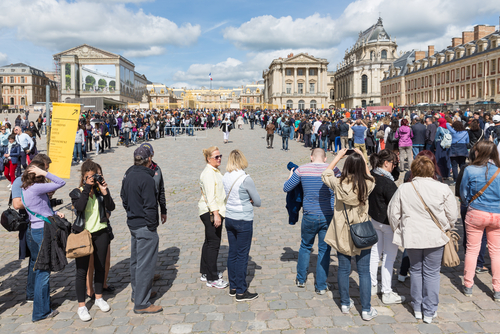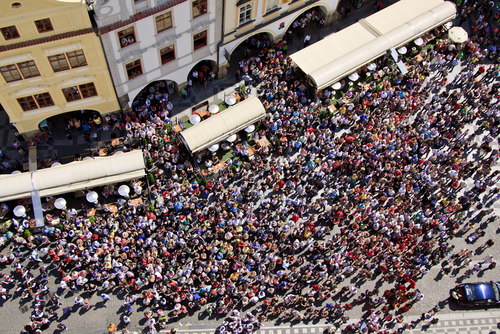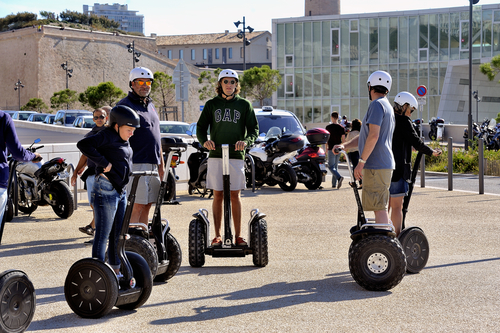‘OVERTOURISM’ IN EUROPEAN CITIES: THE PRESSURE IS ON
September 20, 2016
Posted By: Peter Jordan
Long queues, high prices, angry residents and that creeping feeling that things are getting out of control. The problem of ‘overtourism’ is posing an enormous challenge for some European cities, and a big opportunity for many others.
In recent years, each peak season in Europe’s most popular city destinations has brought with it a higher tide of tourists, frequently peppered with stories of scandalous behaviour and, in reaction, exasperation by local residents. In some cities residents have even set up protest groups to pressure local authorities and raise awareness about the impact of tourists on their daily lives. This has attracted the attention of domestic and international media, causing embarrassment for the authorities concerned. Crucially however, it is also bad news for the tourism sector as a whole.
 Over the past 10-15 years travel in Europe has increasingly become more affordable for Europeans (helped by the growth of low cost airlines), and also for those who live beyond Europe too. The dollar is currently strong against the euro boosting visitation from North America, and for the emerging outbound markets of Asia, the Middle East and Latin America, Europe is a top aspirational destination. In fact, according to UNWTO’s long-term forecast, European countries will see a total of 269 million additional international tourism arrivals during the period 2010-2030. If some of the world’s tourist attractions are already at saturation point, what’s going to happen when these new tourists join the back of the queue and find they can’t get a ticket?
Over the past 10-15 years travel in Europe has increasingly become more affordable for Europeans (helped by the growth of low cost airlines), and also for those who live beyond Europe too. The dollar is currently strong against the euro boosting visitation from North America, and for the emerging outbound markets of Asia, the Middle East and Latin America, Europe is a top aspirational destination. In fact, according to UNWTO’s long-term forecast, European countries will see a total of 269 million additional international tourism arrivals during the period 2010-2030. If some of the world’s tourist attractions are already at saturation point, what’s going to happen when these new tourists join the back of the queue and find they can’t get a ticket? 
As well as growth in volume, the way that people are travelling has changed too. Typically, tourists used to hang out in the city centres, clustering around the main attractions. Today, P2P platforms and travel planning apps allow visitors to rent apartments, eat meals and explore neighbourhoods that they never used to visit, meaning that they are generally in much closer proximity to local residents. Added to this, many European cities are witnessing the type of binge-drinking tourism by partygoers that used to be confined to Europe’s beach resorts. As a result, when temperatures soar and visitors fill the streets it’s logical that local people will ask ‘where’s the limit?’, ‘do we really have to put up with it?’, and ‘what can be done?’ an effect which the Spanish tourism trade portal Hosteltur calls ‘turismophobia’.
Finding the right solution
In the case of small villages or sensitive historic sites, a cap on visitor numbers regulated by paid entry (as scheme started this year by the villages of Cinque Terre in Italy) may make sense. However in the case of sprawling cities, it is undesirable and impractical to impose a cap on visitor numbers. Quite simply, quick-fix or heavy-handed solutions can actually damage a destination’s brand and cause far more problems than they solve. Clearly this is not just a problem for local authorities to solve but a complex issue that all stakeholders (residents, local authorities, tour operators) must work together to tackle in order to achieve the outcome that is both fairest and smartest.
Here at Toposophy we’ve been charting the rising problem of overtourism for sometime, and have even led some pioneering research into this field. Like the sensitive practitioners that we are, we recognise that the solutions to this complex problem are far from simple and can’t be applied on a one-size-fits-all approach. We would however like to share a few ideas that will help city authorities of all sizes. These are broadly centred around two areas: tackling congestion and promoting dispersal.
TACKLE CONGESTION
• Beat the bottlenecks: Start by analysing and tackling the problem areas which cause most irritation among local people. These might be specific pedestrian bottlenecks or noisy neighbourhoods. This is why Barcelona is one of the first cities to install SmartCitizen ‘ambiental monitoring’ kits sensors to monitor noise and pollution levels and generate statistical evidence of tourists’ impact on the quality of life of local residents.
 • Ban or limit certain activities: Some types of tourist business or activity really drag down the the quality of life for local residents very quickly. If controls aren’t applied, highly-frequented areas can quickly become ‘trashy’ as business owners race to capitalise grab tourist euros and for tourists, some methods of getting around town can slow everyone else down. All of this explains why in the past 18 months alone, Amsterdam has banned beer bikes, Prague has banned Segways from its historic centre and Magaluf has introduced tighter laws on pub crawls.
• Ban or limit certain activities: Some types of tourist business or activity really drag down the the quality of life for local residents very quickly. If controls aren’t applied, highly-frequented areas can quickly become ‘trashy’ as business owners race to capitalise grab tourist euros and for tourists, some methods of getting around town can slow everyone else down. All of this explains why in the past 18 months alone, Amsterdam has banned beer bikes, Prague has banned Segways from its historic centre and Magaluf has introduced tighter laws on pub crawls. • Education, education, education: Local businesses catering to tourists are crucial in getting the message across to tourists about respecting local rules, avoiding congested areas and respecting the privacy and quality of life of local people. Tour guides should ensure that tourists are properly briefed on safety and respectful behaviour before they start tours and activities, and it’s worth working with travel influencers and publishers of guides to ask them to stop promoting those activities (like concentrating in a certain place) which cause a problem.
• Keep track of P2P rentals: As shown in our latest report on the Sharing Economy (produced in collaboration with European Cities Marketing), it’s both possible and necessary to keep a handle on the growth of P2P tourist rentals (accommodation, transport, activities). The smart approach is for destination authorities to keep a constant review of what’s going on, and forge partnerships with platforms that can help them meet their policy goals on destination marketing and management, always putting the rights of local residents first.
PROMOTE DISPERSAL
• It’s not just a priority for crowded cities. Political attention is turning increasingly toward the role that tourism plays in the local economy so it’s important for destination authorities of all shapes and sizes to work at spreading the economic benefits of tourism as widely as possible. This has to be done through a combination of smart destination marketing that responds to what visitors really want to see and do and smart management that promotes easier tourist mobility and is more in tune with the needs of local residents.
• Know your markets. Not everyone is keen to set off into the countryside. If it’s a first-time visit to a popular city, then the big sights are going to be a must. So who is up for going off the beaten track? It’s time to start is with a proper evaluation of who’s visiting, where they’re from, how long they’re staying and what attracted them to visit in the first place. Only then can you start to work out which travellers to target, and how to....
 • Appeal to travellers’ sense of curiosity and adventure. Knowing how to attract travellers away from crowded hotspots means knowing how to appeal to their sense of curiosity and how to fulfil their desire for certain experiences (for example, for breathing fresh air, seeing beautiful landscapes or discovering local cuisine). ‘Stepping Out of the Crowd’, our major research project with Visa Inc and the Pacific Asia Travel Association revealed that Millennials were the age group most likely to want to explore beyond the big cities thanks to being tech savvy, having better language skills and being attracted by what rural and coastal areas could bring to their experience. The final report also gave comprehensive recommendations on how to create a dispersal strategy for this group.
• Appeal to travellers’ sense of curiosity and adventure. Knowing how to attract travellers away from crowded hotspots means knowing how to appeal to their sense of curiosity and how to fulfil their desire for certain experiences (for example, for breathing fresh air, seeing beautiful landscapes or discovering local cuisine). ‘Stepping Out of the Crowd’, our major research project with Visa Inc and the Pacific Asia Travel Association revealed that Millennials were the age group most likely to want to explore beyond the big cities thanks to being tech savvy, having better language skills and being attracted by what rural and coastal areas could bring to their experience. The final report also gave comprehensive recommendations on how to create a dispersal strategy for this group. • Respect the vital role of travel influencers. Travel bloggers and influencers are playing an increasingly important role in putting new destinations on the map, and helping to highlight the ‘hidden gems’ of well known destinations. Many bloggers focus on one particular area of interest such as sport, music, art or fashion bringing a new audience with them to a destination to indulge their passion. Bloggers can also be particularly useful in explaining practical advice to an audience in their own language. DMOs can then take this content and curate it for the benefit of travellers who are looking for alternative experiences.
 • Make your destination easy to explore. It’s vital to promote public transport as a means of independent travel, flexibility and exploration. Think about how your visitors see your local bus and metro networks. How user-friendly are they for exploring beyond the centre? Provide key tips, advice on scenic routes and key attractions that are accessible via public transport. Provide clear, transparent information on ticket prices and promotions for visitors.
• Make your destination easy to explore. It’s vital to promote public transport as a means of independent travel, flexibility and exploration. Think about how your visitors see your local bus and metro networks. How user-friendly are they for exploring beyond the centre? Provide key tips, advice on scenic routes and key attractions that are accessible via public transport. Provide clear, transparent information on ticket prices and promotions for visitors. • Encourage off-peak tourism. Dispersal isn’t just about space: where tourists are walking, cycling or sitting (in the way of locals). It’s also about the time of year, and even the time of day that they’re visiting. Tackling seasonality by encouraging people to make their visit during quieter periods is now more important than ever. Destination authorities can also work with local attractions to encourage them to extend opening times and increase capacity.
HOW WE CAN WORK WITH YOU?
Today, it's the job of every DMO to promote dispersal; whether to the suburbs or surrounding cities, as a means of encouraging visitors to spend more nights in the destination, and as a means of spreading the economic impact of visitor spending more widely. Whatever your aim, TOPOSOPHY has the tools to help you:
• We offer a whole range of specialised services relating to visitor management and dispersal, from Tourist Area Place Checks, Visitor Impact Assessments and the creation of Visitor Flow Management Systems. Knowing how important it is to work with partners at every step of the way, we can also assist with setting up and running Stakeholder Forums to keep an open channel of communication and consultation with local residents and business.
• Looking to catch the eye of your visitors? As a business unit of ATCOM, an award-winning digital media agency we’re able to offer you every digital solution you can think of, including electronic display advertising using the most cutting-edge interactive outdoor display technology. Quirky, creative, enthusiastic and highly imaginative, over 150 digital media specialists are ready to put your ideas into action!
• Looking at the bigger picture, our Destination Audits give you a critical evaluation of how your destination is performing, as well as the resources which need to be developed in order to improve your destination management and competitive position in the market
• Looking to start over? Ultimately, destinations of every size need a solid basis for working with partners, setting priorities and moving forward together. Our Tourism Master Plans offer the design of an overall tourism development strategy, a full situational analysis and a complete strategic action plan, offering comprehensive guidelines on tourism product development, marketing & branding and industry education.
• If you’d like to work more with travel influencers or you want to improve the quality of your relationships with them, we offer a tailor-made blogger outreach programme, allowing you and your destination partners to understand how to get the most from working with travel influencers.

COMMENTS